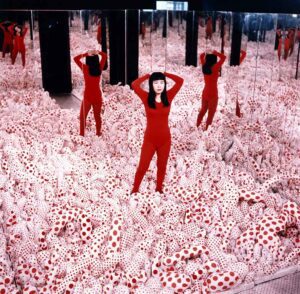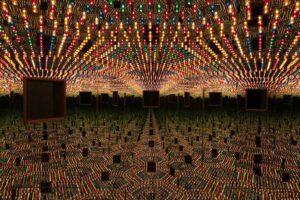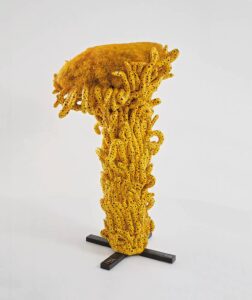
Punpkin
Christian Hain
The retrospective of Japanese artist Yayoi Kusama at Gropius Bau starts in the employees’ parking lot (they do still have one, despite an outspoken political agenda that doesn’t exactly approve of private transport), where we find some trees transformed into a smurf-like village, or fly agaric-styled art objects. “Hard wood, wearing a (white and red-dotted) dress, wrapped up, clothed, covered” – this could have some deeper meaning, as we’ll see later. The colourful – poisonous, though, if we continue that mushroom association – patterns are a key element in Kusama’s work, and feel very welcome in these dark and trying times. Mentioning this, there’s something else: you may not actually visit the show, not right now; it’s confusing, and the rules are changing almost by the day. Not even a week after the preview, MGB was ordered to close the doors again, like all Berlin art venues. The ongoing situation and not the artworks’ supposed value, was also responsible for heightened security measures around that preview, but at least, they might have attracted the curiosity of random passers-by.

Upon presentation of a time-slot ticket, the personal invitation on our smartphone, and a positively negative Covid test not older than 24 hours, we were allowed inside. Peeking through glass doors in the foyer, we see pink tentacles, black-dotted, and reaching high up in the air, as if some mythological beast were breaking through the floor. Silly visitors will feel inclined to mumble, “Ph’nglui mglw’nafh Cthulhu R’lyeh wgah’nagl fhtagn” (https://en.wikipedia.org/wiki/Cthulhu), but we’re still in Berlin, and H.P. Lovecraft was most definitely NOT an inspiration for the artist.
These glass doors are only the show’s exit and securely guarded (Covid laws again, probably), so it’s upstairs first. Many steps and a panting break later, admiring the whole, and huge, installation while being aware of the artist’s nationality, a second, more reasonable, interpretation forms in our mind. Let’s call a spade a spade, all false modesty aside: the most fitting association here goes by the name shokushu goukan, Japanese Tentacle Erotica. Should you not be familiar with the motif, no, that’s not just the outlandish interpretation of a pervy Hentai Kamen fanboy film, but quite common in Japanese art and entertainment, from classic to contemporary. Even Hokusai did it (not literally, but – well, you know, what I mean), go ahead, and google his Dream of the Fisherman’s Wife.
Leaning over the railing, we note two things: the material appears balloonish – not Jeff-Koons-500kg-balloonish, but airy plastic and it’s almost, but not quite, possible to reach out and touch it. That railing being rather low, curiosity could pose an even greater risk to museum goers of all age groups than a certain virus does. Recoiling from the abyss, we enter an exhaustive retrospective starting from Kusama’s beginnings in the 1930s and leading right up to recent years. A photograph accompanying the timeline on a wall shows the artist as a young girl aged 10 in 1939, while the earliest drawing in the room dates from 1934 … wait, this might be a typo? Or was she indeed some sort of drawing wunderkind?
As a general rule, background information can be helpful, but also stand in the way of understanding, especially if that background info says mental illness. Walking around between the early paintings, visitors feel serious Halle St Pierre/Museum of Everything vibes, but are these premature traces of future mental troubles, or merely a debuting artist’s attempts at 20th-century surrealism?
Part of a recreation of Kusama’s first ever exhibition in a local community centre (don’t ever say those are good for nothing!) in 1952, Speurim introduces what would become one of her trademarks: the mushroom patterns, here appearing on a misshapen tongue (or worm?). This, like other images, did not come out of nowhere, has not been deliberately imagined by the artist (is that ever the case?). From an early age, Yayoi Kusama has experienced visual hallucinations of a style, some would describe as ʼshrooms flashbacks, I’m told. She portrays the world as she sees it, and others don’t. We find a quote in reference to the Infinity Nets series, which she began painting in the late 1950s: “I would cover a canvas with nets, then continue painting them (…) the nets began to expand to infinity. I forgot about myself as they enveloped me.” These words also suggest an escape from her true self, body and life.
Presented alongside paintings dominated by the same non-colour, a large scale photograph shows the artist in front of an empty (also for her?) white wall. A young Japanese surrounding himself with whiteness is the equivalent of a Western teenager dressing all in black, easily judged as potentially depressive; white being the colour of death and mourning in Japanese culture. This bit of information could already count for exoticism, supposing different cultural upbringings to result in differently conditioned people in different parts of the world, people thus being different instead of equal everywhere – yet, there might be something to it.
Shades of white are still omnipresent in Kusama Yayoi-san’s first NYC show of 1963, having moved there in 1958. Is the abstract painting Pacific Ocean (1960) motivated by homesickness, fear of the big changes in her life, or, on the contrary, does it mark an escape from learned conventions, to embrace another culture with its whole new set of connotations, where white is no longer Japanese white, but Gaijin white, and an innocent new start?

The wall text tells about depression, poverty, and visa struggles.
In that same show, the Gertrude Stein Gallery sold an installation, which we likewise find at MGB today: white and very phallic row boats painted on black walls surround an actual white row boat covered with very phallic plaster objects that are aiming in all directions, some dangling limp, some standing, well, (half-)erect, some even strategically placed on the rowing bench. From this point on, visitors can no longer escape a second key element in Kusama’s art beside psychopathology, and that’s the erotic/sexual aspect – or let’s put it in the most low-brow, but very hip internet meme slang: all together now; ‘Psychology has long moved on from Freud’ – Yayoi Kusama: Hold my beer.’ (/saké).
The artist’s ultimate breakthrough followed with another show two years later, now at Castellane Gallery, and works like Phallis’ Field: A room with white, red-dotted phalli on the floor – pick one like a flower? – and mirrors for walls. The door could be closed from the inside, yet stands wide open, securely locked in place, and MGB’s warden couldn’t enlighten me as to the original concept. This was the first of many infinity mirror rooms to come, spaces for the visitor to get lost in, melting in and outside, mingling reflections of self and abstract patterns, challenging the perceptions of self and reality.
Kusama’s style more and more mirrors the style of an era, to a point that many works don’t seem necessarily unique, or personal, but a typical expression of the 1960s and 70s, right there in line with lava lamps, French fashion, and hallucinogens. Kusama’s natural highs must have resonated greatly with society at a time when Timothy Leary had only recently quit his practical research projects at Harvard (“Turn on, tune in, and drop out”, sounds like a perfect slogan for Kusama’s art, too). We follow her to shows all over the US and Europe, watch extracts from contemporary French and German TV documentaries next to videos of happenings and performances that look exactly what you’d imagine a decent 1960s/70s happening or performance to look like.
In a way, you might think, Kusama became the artworld’s beloved star, a compatriot of hers always wanted to be, and she is undoubtedly more talented than Yoko Ono. With macaronis – indeed, you got that right: solid, unboiled pasta – another element joins her installations, and we wonder about the inspiration. Despite having just cited that other Japanese artist, any unrequited feelings for Paul McCartney seem very improbable.
Noodles in all forms and variations, noodles and … more phallic symbols, in many colours, occasionally red-dotted phalli, and… balls, or actually spheres, half-spheres, like silver bowling balls. On a poster we see the artist tossing one of them away (they cannot have been very heavy).
We discover Yayoi’s adventures in fashion wonderland, which were more than a digression: Kusama successfully orchestrated an empire of boutique stores to sell her self-designed clothes and accessories (take note: Takashi Murakami is not the first Japanese art megastar with an attached merchandising business). Total art and entertainment: Kusama was definitely a part of the 1970s.
It’s not very important, only a detail in the literature of the show. The sentence confirming their relationship as only friends is the only occasion when Gropius Bau tells us anything about Yayoi’s relationships (at least I haven’t noticed other examples).

Sadly, we don’t learn much about her artist connections and mutual influences, with the exception of some words on a close (but not physically intimate) relationship to Joseph Cornell. She should at least have gotten along well with the Gutai group. Having participated unofficially in Biennale 1966 – showing her art in the streets of Venice like a tourist, she was finally invited in 1993.
Kusama’s Peep Show may justifiably be called one of the most impressive examples of Op Art, as looking through a tiny window, we catch glimpses of an alternate reality: a thunderstorm of blinking rainbows, not unreminiscent of a 1970s disco dance floor (only misses some seriously bearded singer in a tight white tracksuit if movies and music videos are anything to go by).
Other many mirrored rooms of the Infinity sort are even more immersive and intimate, and must be entered – or should we say penetrated? – to discover objects and patterns, fluorescent double helix-shaped tube lights or atom models, dimming and relightening, of course all surrounded by mirrors again. They admittedly left us searching for the exit. There are so many, but which one is real, i.e. leading back to (our) reality?
Another example adds a further dimension to the room in a room concept, when MGB’s walls are painted in the same fashion as the insides of a large cube, and now the mirrors are on the outside, too (sounds complicated? (just see the picture). The patterns in this case seem to summon Halloween pumpkins, yellow with black dots, but don’t be afraid of your own reflection.
Great art and great spectacle don’t need to be mutually exclusive. It’s all very trippy, but is it a good trip or a bad one? Referring to the artist, we cannot be sure; the art aficionado certainly has a great time. Perhaps it all boils down to the old saying: there’s a thin line between genius and insanity, maybe none at all. Also to another, more fundamental question: could there be indeed something like the higher truth of madmen? Dots, vectors, what if some were able to gain insights into a higher order of things, catch a glimpse of the matrix, beyond reality, and open those doors of perception, to transcend natural science that only allows us one possible representation of the world? We don’t know about that, but we feel that it’s better this way. Though infinity can look wonderful, it comes with a price, namely the forlorn feeling that man doesn’t belong there, lost among endless reflections of shapes, self, and colours.
Yayoi Kusama never gave up painting entirely, and at certain times even intensified her production on canvas. Now living in a mental hospital – by her own choice, as stresses Gropius Bau. They seem eager to downplay the mentally unconventional condition, also citing issues of physical health as the reason for her return to Japan as early as 1973 – the late works appear post-surrealist. Some could be influenced by Australian aboriginal art, or is this just coincidence, maybe even by unconscious spiritual links?
Another mystery remains unsolved in a great, and multifaceted, retrospective: what are those dots and circles good for that we find here and there, in fact almost everywhere throughout the exhibition, painted on the floor like colour code charts?
On the way home, I realized that I did not wander among the tentacles as I’m sure to have seen others do from above (and it really wasn’t just a hallucination … I guess). The circuit led me past the main entrance, the restrooms and an improvised Covid test station in the basement straight to a back door. Thinking about those tentacles again, I found another association: flames. …No, not really, tentacles it is.
Yayoi Kusama, A Retrospective: A Bouquet of Love I Saw in the Universe, 23 April – 15 August 2021, Martin Gropius Bau
Volume 35 no. 6 July/August 2021

